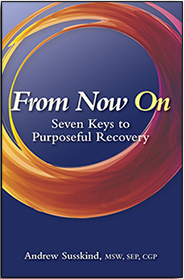Because we are most defended against our greatest needs, intimacy is an emotionally-precarious territory. Over time, you learned to build self-protective walls due to past hurts, disappointments, and intrusions, but in recovery you can safely break down your walls and learn to rely on others gradually. If you’re determined to heal old relationship wounds, being in a relationship is the best place to work on them—whether it be romantic, friendship or family. As you step into the healing properties of emotionally-reliable relationships, avoidance will fade away making room for trust and respect to grow. Walking through your fears and vulnerabilities will promote deeper contact and healthier versions of relationships.
Early attachment patterns begin with the baby longing for the gleam in the eye from the parent or caregiver. The gleam lets the child know that he is a precious, valuable human being. We all have a deep wish to be loved from the time we’re born, and the experience of being seen as a lovable, desirable person sets the stage for trust, respect and intimacy. If all of these necessary ingredients are present, you’re on your way to emotionally-nourishing connections.
In his book, Addiction as an Attachment Disorder, Dr. Philip Flores explores the fundamental role of attachment as applied to substance abuse, and his theory can also be applied to sexual compulsivity. He describes addiction as “a condition of isolation which often originates with insecure attachments. Not everyone with inadequate attachment experiences will become addicted, but everyone with an addiction suffers with attachment difficulties. Addiction occurs when the attachment to a behavior or a substance becomes stronger than the attachment to people and caring, loving, nurturing relationships.” With out-of-control sexual behavior, compulsive urges increase when the attachment to self-destructive behaviors remains stronger than the attachment to real relationships in your life. Therefore, true healing takes place when the attachment to intimate relationships overpowers the attachment to compulsive sex.
Accept your need for others because it’s part of your foundation for emotional sobriety. In our society, which highly values autonomy, accepting the fact that you need others to survive is often overlooked. As a result, self-sufficiency is highly encouraged, and asking for help is often discouraged. When you learn to lean on dependable people, the early attachment gaps fade and emotional repair begins. Because you’re biologically-wired for connection, your brain will respond to the newly-forming intimate pathways as a welcome change rather than a scary one. How do you do this? Through twelve-step involvement, psychotherapy, coaching and volunteering, you’ll have the opportunity to move toward community and belonging rather than perpetuating isolation and disconnection.
Gradually, you’ll learn to trust and internalize your recovery team—those you have chosen to be with you in this chapter of your life. You get to pick your team, so choose wisely. By cultivating nurturing relationships, you’ll be well on your way to living your life with contentment and love. Sprinkle in some meditation, exercise and overall self-care and you’ll fill up your recovery toolbox.
In summary, your long-term prognosis for sustainable recovery is dependent upon your capacity for more satisfying, nourishing relationships. Avoidant attachment patterns are self-protective, yet they get in the way of what you really want—love and belonging.
Action Steps:
- Lean into safe, loving relationships gradually rather than avoiding them. Become the pursuer rather than the distancer. Who would you like to pursue as a friend or confidant? Consider your options and choose one relationship to pursue.
- Be a giver of love even if it’s scary, uncharted territory. Notice when love shows up in front of you, and take note of how it feels on the inside. Track loving moments—both giving love to others and receiving love from others.
- Learn from your pets. They are instinctive teachers of unconditional love, acceptance, and play. If you have a pet, pay attention to their unconditional love and acceptance. Savor it. If you don’t have a pet, consider fostering one or volunteering at your local shelter.
- Take inventory of the most intimate friendships in your life. Write a list of your past relationships that have been most meaningful. Identify their commonalities.
- Notice when you feel more trust and relaxation in relationships. Without these qualities present, intimacy doesn’t exist. Be mindful when you’re feeling more relaxed with others. Take note of what happens inside of you and how this indicates deepening trust.
Identify your people and cultivate deeper contact through vulnerability and emotional risk-taking. Be the reliable person you would like to experience with others. Consider small emotional risks and show up wholeheartedly for relationships—one intimate relationship at a time.




